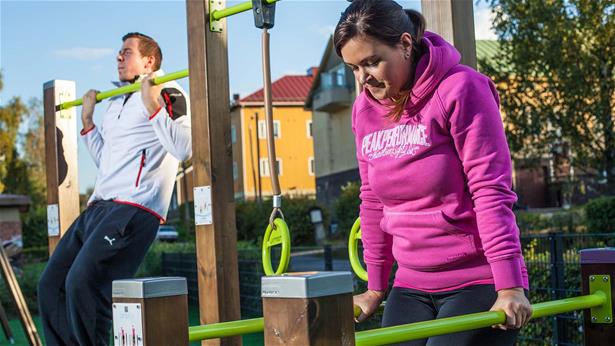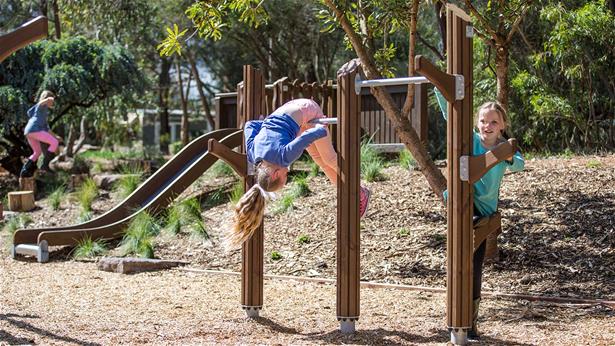AS SAFE AS NECESSARY – INSTEAD OF AS SAFE AS POSSIBLE
Contents
It’s easy to distinguish a kids’ playground from a outdoor fitness site. However, designers tend to prefer that the area serves a wide range of users. Often the sites provide playground equipment for children and fitness equipment for adults. While it is fully possible to prepare a creative plan for such a site, it’s important to follow a few ground rules.
A number of new product standards have been introduced over the past few years, such as EN 16630 for outdoor fitness equipment and EN 16899 for Parkour equipment. Additionally, a new technical report (TR 16879) has been published describing how playground and fitness equipment should be distinguished from each another.
Separation of areas with different levels of risk
Playground equipment is to be placed in groups intended for different age groups. More importantly, the playground equipment needs to be distinguished from fitness equipment in some way.
This is not to stop children from having access to the fitness area and so make it impossible for them to use equipment involving a higher level of risk. Instead, the idea is to make sure that children do not inadvertently move over and start using the more risky fitness equipment.
The bigger the difference in risks between the two areas, the more clearly they must be distinguished. For example, in reality, this means that a fitness area adjacent to a playground should not have any skating ramps, free weights or muscle-training equipment that poses a risk of crushing.
Equipment selection
To ensure that a higher-risk fitness area is not confused with a playground, the equipment must look like fitness equipment and must not include any playground structures such as swings or climbing frames with slides, etc.
Some pieces of fitness equipment may have two distinctly different uses. For example, chinning bars are common in playgrounds. It’s a simple climbing device allowing children to hang and swing from it and even climb to sit on top of it. In playgrounds, the bar is usually installed at a low height, maybe one metre from the ground. At the same time, the chinning bar is a full-fledged fitness device when placed high enough in a fitness area where the free height of fall is one metre lower than in playgrounds.
Impact absorbing surfacing
A lot of things have been said and written about the impact absorbing surfacing of playgrounds. Simply said, there are three things to be considered when it to comes to impact areas: the size of the area, the required shock absorption capacity based on the free height of fall, and elimination of overlapping impact areas where forced movement is involved.
If a piece of fitness equipment, say a chinning bar, is placed next to a playground, its impact absorbing surfacing must meet the same requirements as the rest of the playground area. However, if the area is designed exclusively for fitness use, the requirements are less stringent.
Muscle-training equipment, including stationary equipment like the chinning bar, can be installed on a harder surface than playground equipment. Up to the free height of fall of one metre, the surface may be completely hard. A lawn or topsoil is acceptable up to a free height of fall of 150 cm. As fitness equipment normally does not involve any forced movements, the impact areas may overlap.
When a Parkour area is designed exclusively for training and not for play and it is located away from any playground, the equipment may be installed on a completely hard surface up to the free height of fall of 160 cm. With greater heights of fall, the shock absorption capacity must be equivalent to two thirds of the free height of fall specified for the product. For example, a structure with a height of 240 cm may be installed on a surface with a critical free height of fall of only 160 cm.

A chinning bar, placed in a fitness area, has a free height of fall one meter lower compared play areas.

Chinning bar, located in a play area, is a climbing equipment allowing children to spin, climb and even sit on it.
If a piece of fitness equipment, say a chinning bar, is placed next to a playground, its impact absorbing surfacing must meet the same requirements as the rest of the playground area.
Safety and environmental design
Safety is not an end in itself. In fact, safety considerations can be very restrictive. It’s not uncommon for good ideas to stumble because of regulations. Paradoxically, the less you know about the regulations, the more restrictive they appear.
However, the worst thing is to be completely unaware of them. A design error may result in liability for accidents or at least costly repairs.
>> For example, a 4-metre high bouldering wall may mistakenly be provided with 50 mm thick shock absorbing matting.
The second worst thing is to have a generalised idea of the regulations and interpret them as strictly as possible. If so, many good ideas are never realised, but at least you don’t make any mistakes!
>> For example, stationary, child-friendly muscle-training equipment in the vicinity of a playground may be surrounded by an unnecessary fence.
Ideally, the designer is familiar with the regulations and underlying principles. This makes it possible to apply the requirements correctly and, if necessary, find creative solutions to compensate for the risks so that the final design offers an adequate level of safety.
>> For example, the designer knows that a chinning bar installed in a fitness area at a height of less than 220 cm can be placed above a layer of fly ash gravel. At the same time, the designer knows that a fall from the bar is a significant risk and therefore it is advisable to provide a shock absorbing substrate consisting of a 30 cm layer of wood chips or shock absorbing mats of maximum thickness under the bar and to a distance of one metre in front of and behind the bar, while the rest of the impact area may be covered with fly ash gravel.
Consequently, the overriding principle in environmental design should be:
“Not as safe as possible but as safe as necessary.”

